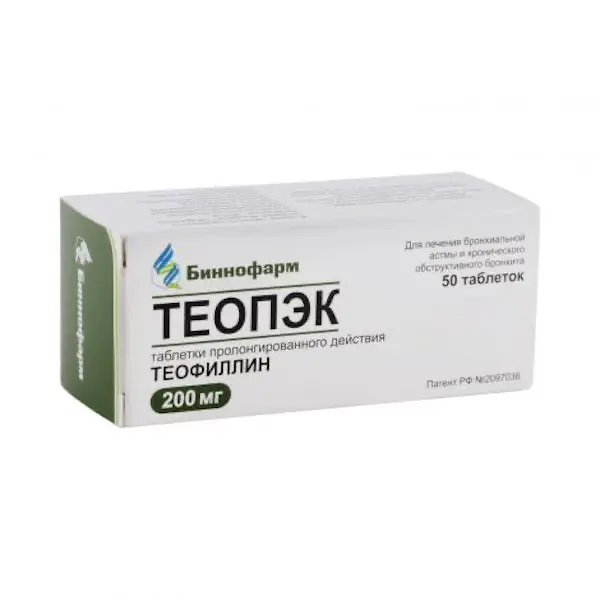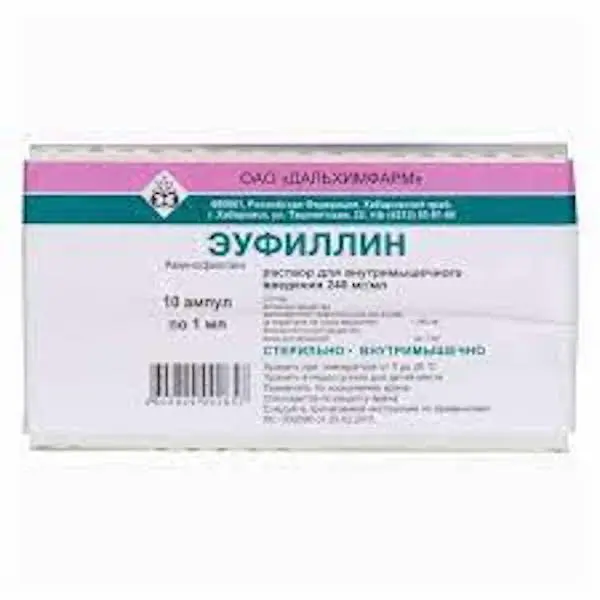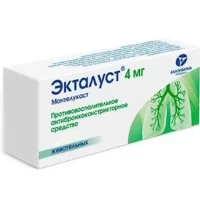Description
Theopec Pharmacodynamics
Theophylline refers to phosphodiesterase inhibitors. It increases accumulation of c-AMP in tissues, which decreases contractile activity of smooth muscles. Theophylline dilates the bronchi, blood vessels (mainly brain, skin and kidney vessels). It reduces pulmonary vascular resistance, lowers pressure in the small circle of circulation. Increases renal blood flow. It has a moderately pronounced diuretic effect. Inhibits platelet aggregation. It has a stimulating effect on the respiratory center, increases the frequency and strength of heart contractions. Delayed release of the active substance from the tablet ensures reaching therapeutic level of theophylline in blood 3-5 hours after administration of Theopec and persists for 10-12 hours. Twice-daily administration of the drug allows obtaining effective concentrations of theophylline in blood within a day. Due to long-term action of the drug, one of the important indications for its use is prevention of nocturnal and pre-morning bronchospasm phenomena.
Indications
Treatment and prophylaxis of bronchoobstructive syndrome in bronchial asthma, chronic bronchitis, chronic obstructive pulmonary disease (COPD), pulmonary emphysema, dermatorespiratory syndrome and other respiratory diseases.
Contraindications
Hypersensitivity (including. other xanthine derivatives – caffeine, pentoxifylline, theobromine), acute myocardial infarction, severe arterial hyper- or hypotension, common atherosclerosis, severe cardiac rhythm disorders (severe tachyarrhythmia, extrasystole), thyroid hyperfunction, Gastric and duodenal ulcer in the acute stage, gastritis with hyperacidity, gastrointestinal bleeding, epilepsy, increased seizure activity, hemorrhagic stroke, retinal hemorrhage, pregnancy, childhood under 3 years, childhood under 7 years (200 mg), childhood under 12 years (300 mg).
Caution
Severe angina pectoris (III-IV AC), heart failure, hypertrophic obstructive cardiomyopathy, significant liver and renal dysfunction, gastric and duodenal ulcer (history), recent history of gastrointestinal bleeding, prolonged hyperthermia, gastroesophageal reflux, prostatic hyperplasia, porphyria, patients treated with anticonvulsants.
Administration during pregnancy and lactation
The safety of use during pregnancy and breast-feeding has not been studied. The drug is contraindicated in pregnancy. If it is necessary to apply the drug during breast-feeding, breast-feeding must be discontinued.
Dosage and administration
- Theopec is taken orally after a meal with water. The tablet is not crushed, chewed or dissolved in water.
- The daily dose is divided into two doses, 12 hours apart.
- The optimal dose is chosen individually, depending on the nature of the disease, age and weight of the patient.
- The drug is prescribed 2 times a day to adults and children over 12 years old by 300 mg, to children from 7 to 12 years old – by 200 mg, from 3 to 7 years old – by 100 mg.
- On the first day, treatment begins with half of the daily dose in two doses. In the absence of adverse reactions, go to the full daily dose.
- The duration of using the drug depends on the peculiarities of the course of the disease and the therapeutic effect. For smokers and persons with increased metabolism, the initial dose is 300 mg, and the maintenance dose may be increased up to 3 times a day. In patients with decreased drug clearance, the initial dose is 200 mg/day, which is then increased by 200 mg in 2 days to a maintenance dose of 400 mg/day in 1 dose in the evening, and in patients with body weight less than 60 kg – 200 mg/day.
- On average, the course of treatment may last from 2 weeks to 2 months.





